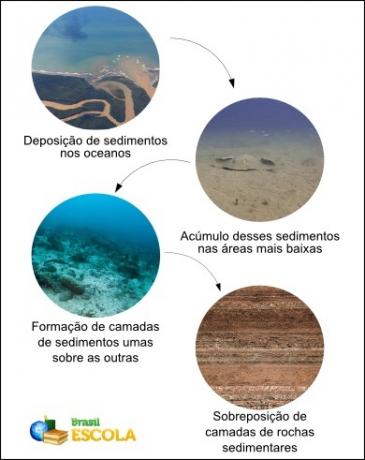At sedimentary basins are a type of geological structure characterized by their presence in areas of relative depression or absolute resulting from the accumulation of sediments (rock particles), forming several layers of rocks sedimentary This structural composition is important for making possible the formation of fossils and fuels such as oil and natural gas.
When the rocks wear out due to the action of external or exogenous agents of relief transformation, they give rise to sediments. An example of sediment is beach sand, formed from the erosion of coastal rocks by seawater. Another example is the dust that is formed from the wear of rocks by the action of rainwater and wind.
These sediments are “carried” by air movements and, mainly, by water, both from rivers and from rain. Thus, by the force of gravity, they tend to be taken to the lower areas and accumulate there, usually in oceanic regions.
So, over millions of years, these accumulated sediments are being superimposed by more and more sets of new sediments, which exert an ever greater “weight”. Thus, the lower layers are being “crushed” by a pressure that is always increasing, causing the rock particles to unite, forming sedimentary rocks.
As this process repeats itself over geological ages, more and more layers of sedimentary rocks form. When they occupy large areas and significant depths, we have the formation of sedimentary basins. Check out the explanatory scheme below:
Do not stop now... There's more after the advertising ;)

Explanatory scheme of the process of formation of sedimentary basins
After or during the occurrence of this long and slow process, the movement of tectonic plates may be responsible for taking the areas of these sedimentary basins to continental regions. This is because the planet is in constant transformation, so that areas that are now oceanic may in millions of years turn into mountain ranges or even deserts.
The formation of fossil fuels and objects
During this process of overlapping sediment layers, it is common that some organic remains of animals are eventually “buried”. Thus, they end up being between one layer and another, so that, depending on the conditions of temperature and pressure, they could give rise to fossils. In some cases, the remains of animals and plants can suffer such a strong force that they can end up “melting” or, more precisely, lithifying. This process gives rise to fossil fuels such as oil and natural gas.
It is important, therefore, to correctly understand the process of formation and transformation of sedimentary basins, as they guard a zone of interest ranging from the scientific field (allowing us to study the earth's past) to the economic field, through the extraction of ores and Hydrocarbons.
By Rodolfo Alves Pena
Graduated in Geography
Would you like to reference this text in a school or academic work? Look:
PENA, Rodolfo F. Alves. "Sedimentary basins"; Brazil School. Available in: https://brasilescola.uol.com.br/geografia/bacias-sedimentares.htm. Accessed on June 27, 2021.

